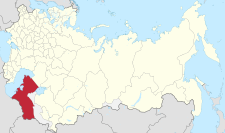Transcaspian Oblast
Transcaspian Oblast
Закаспійская область | |
|---|---|
 Location in the Russian Empire | |
| Country | Russian Empire |
| Governorate-General | Turkestan |
| Established | 1881 |
| Abolished | 1921 |
| Capital | Askhabad |
| Area | |
| • Total | 605,150.93 km2 (233,650.08 sq mi) |
| Population (1897) | |
| • Total | 382,487 |
| • Density | 0.63/km2 (1.6/sq mi) |
The Transcaspian Oblast,
It was bounded to the south by
The name of the oblast (literally, 'Beyond [the] Caspian') is explained by the fact that until the construction of the
.
History
| History of Turkmenistan |
|---|
 |
|
|
Transcaspia was
During the revolutionary period of 1917 to 1919, parts of Transcaspia were
Demographics
As of 1897, 382,487 people populated the oblast. Turkmens constituted the majority of the population, and significant minorities were Kazakhs and Russians. The total Turkic-speaking population was 328,059 (85.8%).
Ethnicity
Overall
According to the
| Ethnic group | Population | Percentage |
|---|---|---|
| Turkmens | 248,651 | 65% |
| Kazakhs | 74,225 | 19.4% |
| Russians | 27,942 | 7.3% |
| Persians | 8,015 | 2.1% |
| Total | 382,487 | 100% |
By okrug
Ethnic groups by percentage of the Transcaspian population according to the 1897 census:[4]
| Okrug (district) | Turkmens | Kazakhs | Russians | Persians |
|---|---|---|---|---|
| Ashgabat | 73.1% | - | 12.8% | 3.3% |
Krasnovodsk
|
62.4% | 19.3% | 9.7% | 3.4% |
Mangyshlak (centred on Fort-Aleksandrovsk )
|
4% | 93% | 2.6% | - |
| Merv | 88% | - | 4.5% | 0.8% |
Tedjen
|
82% | - | 7.9% | 4.1% |
| Total | 65% | 19.4% | 7.3% | 2.1% |
Ethnic groups by population in Transcaspia according to the 1897 census:[4]
| Okrug | Turkmens | Kazakhs | Russians | Persians |
|---|---|---|---|---|
| Ashgabat | 67,443 | 22 | 11,763 | 3,206 |
| Krasnovodsk | 33,529 | 10,394 | 5,222 | 1,822 |
| Mangyshlak | 2,767 | 63,795 | 1,795 | 6 |
| Merv | 104,980 | 11 | 5,321 | 964 |
| Tedjen | 39,932 | 3 | 3,841 | 2,017 |
| Total | 248,651 | 74,225 | 27,942 | 8,015 |
Notes
References
- G.N. CurzonRussia in Central Asia (London: Longmans) 1889 pp1-15
- ISBN 978-0-19-954737-1.
- ^ Richard A. Pierce Russian Central Asia 1867-1917 (Berkeley: University of California Press) 1960 pp88-9
- ^ a b c "Справочник статистических показателей" [Handbook of statistical indicators]. Demoscope Weekly – Application (in Russian).
- Kropotkin, Peter Alexeivitch (1888). . Encyclopædia Britannica. Vol. 23 (9th ed.). pp. 511–513.
- Kropotkin, Peter; Bealby, John Thomas (1911). . In Chisholm, Hugh (ed.). Encyclopædia Britannica. Vol. 27 (11th ed.). Cambridge University Press. pp. 170–172.

